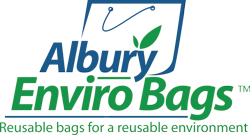Green bags for groceries, and promotional bags for specialty shopping, are becoming more and more common. And the planet is thanking us all for it – don’t doubt that! But it means that the bags that do something different will really be the ones that stand out from the crowd, and serve the best marketing and branding purposes. Heat transfer printing is one of the technologies that green bag and promotional bag manufacturers use to get colourful, realistic, stand-out results – we look at the process and how it differs from the other common printing methods for environmental bags.
The heat transfer printing process
The easiest way to understand heat transfer printing is to think of the iron-on transfers you might have put on your tshirts while at school – the type that are used for scouts and guides badges, sports emblems and school crests. The printing is actually done onto a special commercial heat transfer paper, and although it works by the same method as home iron-ons, the quality is completely different. Commercial heat transfer paper, applied with a heat press (which we’ll explain in a second), does not peel, bleed colours, or fade. The bags are as washable as non-printed or silk-screened products.
The process involves:
- Image or logo is retouched in Photoshop for best clarity and contrast
- Image is printed onto heat transfer paper
- Image may be cut either by hand or by machine, leaving a small border around the edge
- It is positioned on the promotional bag using laser technology to ensure accuracy
- It then goes through a heat press, which applies hundreds of pounds of even pressure, steam and heat.
- The image blends with the fabric fibers and becomes a pat of the green bag itself
What are my options? Silk screen printing
Unfortunately there isn’t an easy way to understand silk screen printing! You just have to read about it. The process for screen printing promotional bags sounds a little back-and-forth, but it is actually a very economical method, due to lower materials costs.
- Your image is separated into its different colors – each additional colour requires a new screen and a repeat of the process, so three-colour promotional screen printed bags can be significantly more expensive than single colour.
- Each coloured part is printed on transparency paper in black
- A silk screen with a UV-sensitive emulsified coating is prepared.
- The image is placed onto the screen, and the lights are turned on
- The UV-sensitive coating will harden where it is exposed to the light, but remain liquid where it is not. Your image, printed in black, prevents the emulsion from hardening
- The lights are turned off, and the soft part of the screen (in the shape of your image) is washed out
- The promotional bag is placed underneath and ink is pushed through the silk screen holes
- The promotional bag is exposed to heat to cure the ink
- The process is repeated for each different colour.
The advantages of heat transfer printing
These are quite a few – but are offset by a slight increase in cost. If you are making a large order of promotional bags, though, the difference is usually negligible.
- There is no interaction between the image colour and the background colour
- Colours and borders stay vibrant and well delineated
- You can utilize photos on your promotional bags – silk screen printing doesn’t allow this: heat transfer, unlike silk screen, allows accurate reproduction of colour gradients and shadows thereby maintaining realistic colour and 3D effects.
Sources:
http://www.localheroclothing.com/heattransfer.htm
http://www.localheroclothing.com/silkscreen.htm
http://www.bestblanks.com/heattransferfaq.html
http://www.ehow.com/about_5098204_heat-transfer-printing.html
http://www.ehow.com/how_4600423_heat-transfer-paper-work.html
http://www.alburyenvirobags.com.au/printed-bags.php




